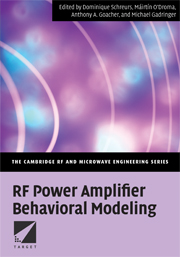Book contents
- Frontmatter
- Contents
- Notation
- Abbreviations
- Preface
- 1 Overview of power amplifier modelling
- 2 Properties of behavioural models
- 3 Memoryless nonlinear models
- 4 Nonlinear models with linear memory
- 5 Nonlinear models with nonlinear memory
- 6 Validation and comparison of PA models
- 7 Aspects of system simulation
- Appendix A Recent wireless standards
- Appendix B Authors and contributors
- Index
4 - Nonlinear models with linear memory
Published online by Cambridge University Press: 06 January 2010
- Frontmatter
- Contents
- Notation
- Abbreviations
- Preface
- 1 Overview of power amplifier modelling
- 2 Properties of behavioural models
- 3 Memoryless nonlinear models
- 4 Nonlinear models with linear memory
- 5 Nonlinear models with nonlinear memory
- 6 Validation and comparison of PA models
- 7 Aspects of system simulation
- Appendix A Recent wireless standards
- Appendix B Authors and contributors
- Index
Summary
Introduction
Conventional nonlinear static models, such as AM–AM and AM–PM representations, are frequency independent and can represent with reasonable accuracy the characteristics of various amplifiers driven by narrowband input signals. However, if an attempt is made to amplify ‘wideband’ signals, where the bandwidth of the signal is comparable with the inherent bandwidth of the amplifier, frequency-dependent behaviour will be encountered in the system. This kind of phenomenon is described as a memory effect and can be classified as linear or nonlinear (subsection 1.2.2) or as short- or long-term (subsection 2.4.1). Taking account of both nonlinearities and memory effects when modelling a PA becomes very important in wideband system designs.
In this chapter we focus on investigating nonlinear models that include memory effects (i.e. frequency-dependent behaviour) by using linear filters. The models considered are categorised, according to the selected structure, as two-box, three-box or parallel-cascade models. In the two-box-model section the Wiener and Hammerstein models are discussed, while the three-box-model section includes the Poza–Sarkozy–Berger (PSB) model and the frequency-dependent Saleh model. These models represent some first attempts at extending the nonlinear static AM–AM and AM–PM models to cover frequency-dependent effects. The Abuelma'atti and polyspectral models are major representatives of models organised in parallel branches describing linear memory and will be introduced in the parallel-cascade-model section.
Two-box models
The two-box modelling technique is also known as the modular or feed-forward block-oriented approach.
- Type
- Chapter
- Information
- RF Power Amplifier Behavioral Modeling , pp. 136 - 162Publisher: Cambridge University PressPrint publication year: 2008

